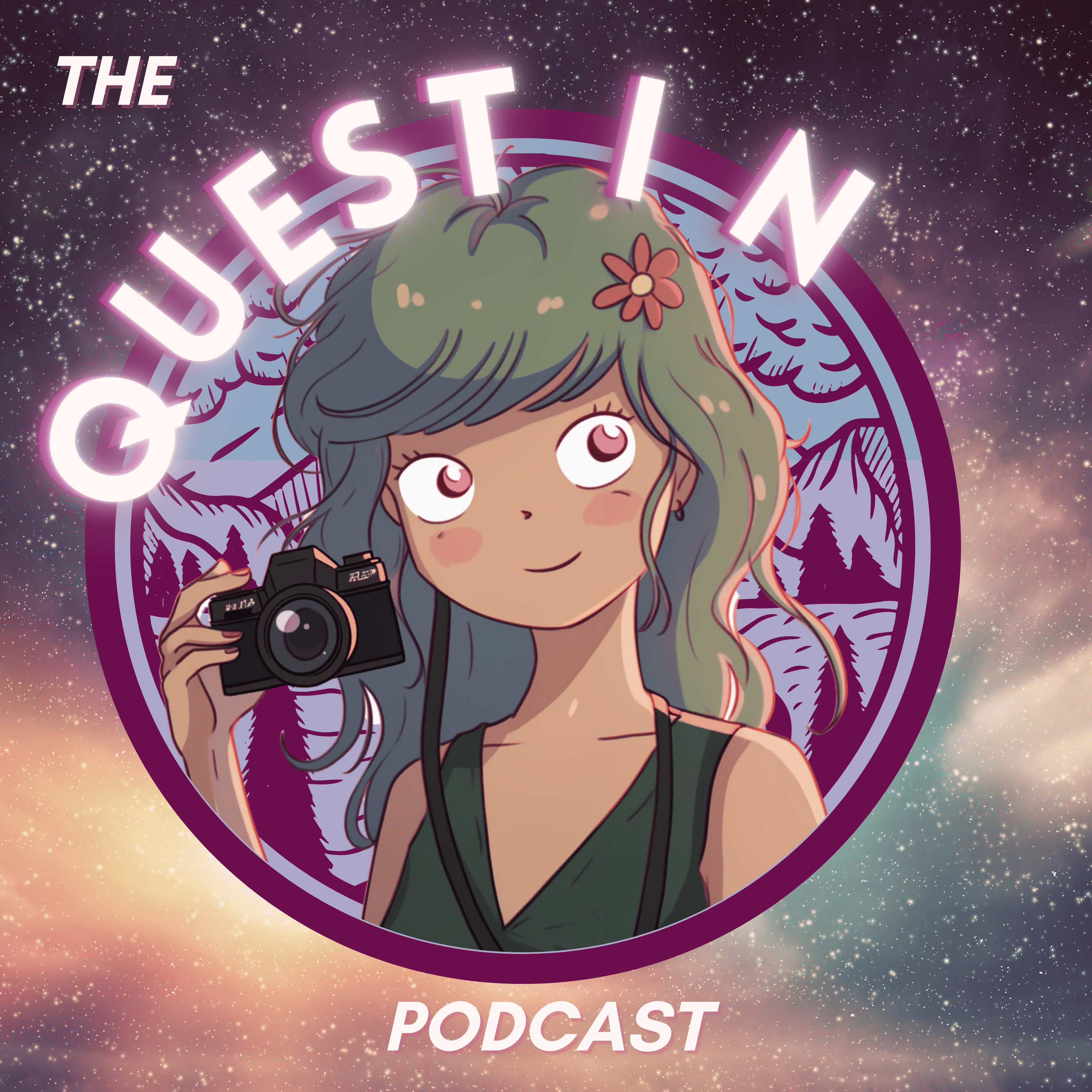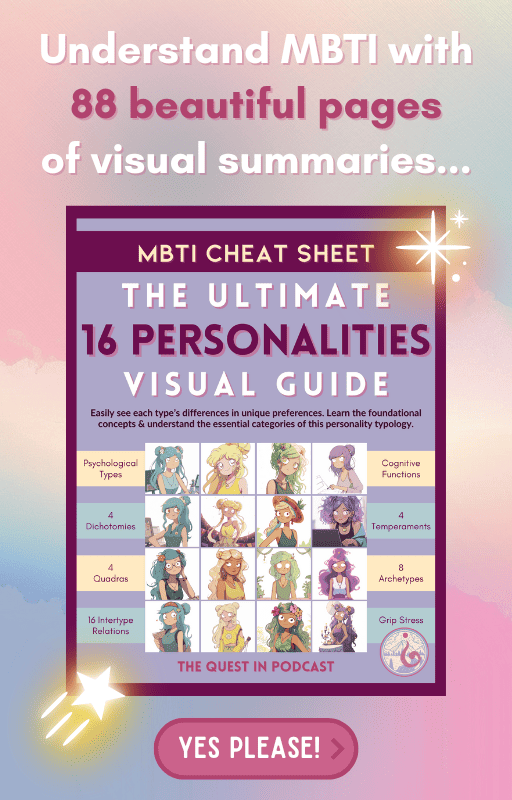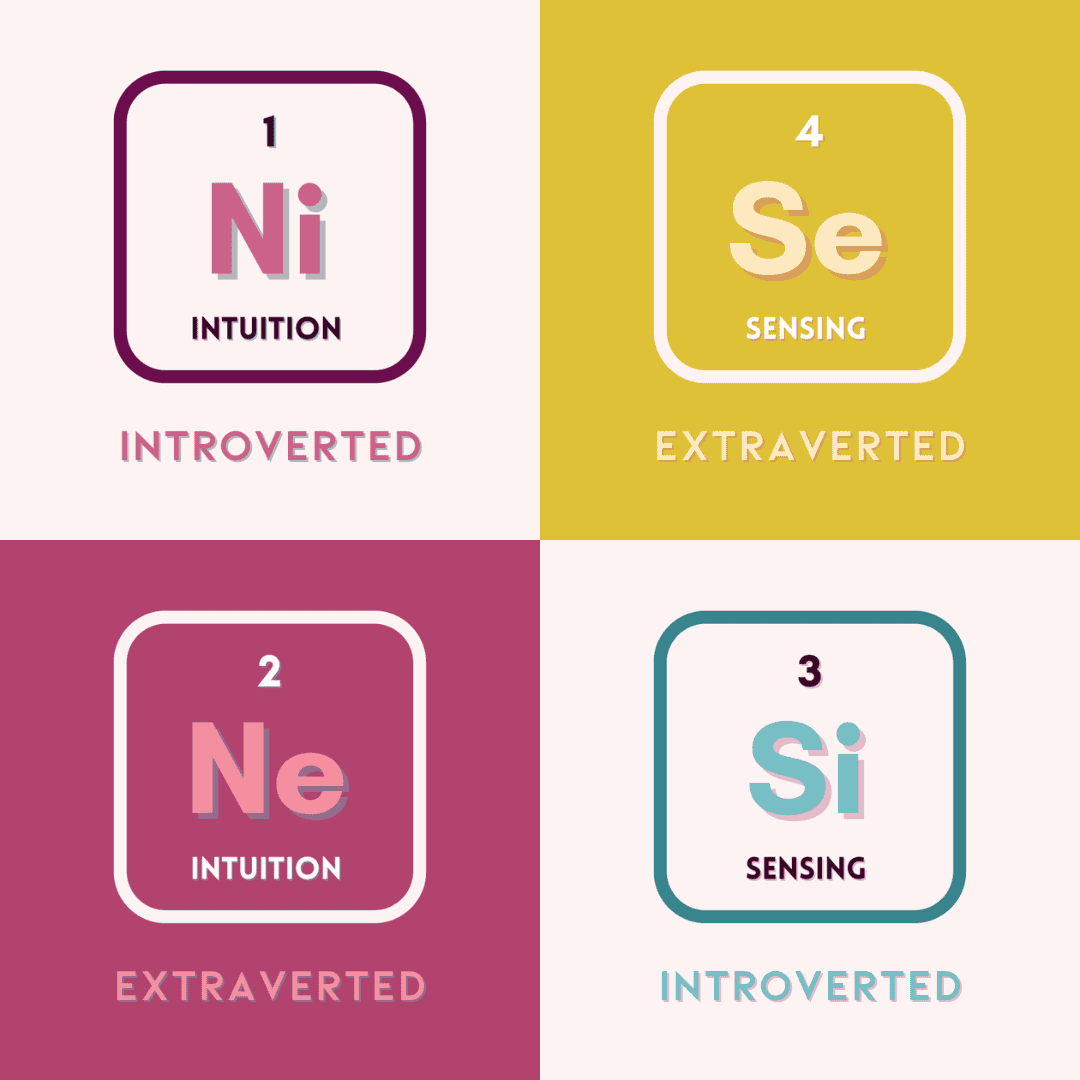
MBTI Cheat Sheet: The Ultimate 16 Personalities Visual Guide
What’s in a Myers Briggs/16 Personality Types Cheat Sheet?
This Ultimate 16 Personalities Visual Guide is a quick and easy cheat sheet you can reference anytime for all the essential foundational frameworks to understand the psychological types well. Use as a quick MBTI manual for simplified illustrations of each function stack, the cognitive functions, and how to optimize for personal growth.

I’ll share with you the content outline of my MBTI guide so that you can preview all the value I jam-packed into its pages.
Sections of The Ultimate 16 Personalities Visual Guide
- 16 Psychological Types
- 4 Dichotomies
- 4 Temperaments
- 4 Quadras
- 8 Functions
- 8 Archetypes
- 16 Intertype Relations
- 16 Types in Grip Stress
What You Will Learn in the Cheat Sheet
These are the basic foundational concepts of the MBTI personality framework. The MBTI cognitive functions were actually first conceptualized in the early 1900s by Carl Jung, when he published his Psychological Types book in 1921. He identified the cognitive functions of introverted intuition (Ni), extroverted intuition (Ne), introverted sensing (Si), extroverted sensing (Se), introverted feeling (Fi), extroverted feeling (Fe), introverted thinking (Ti), extroverted thinking (Te).
Then, Myers and Briggs mother-daughter duo expanded upon his ideas to add structure to the personality typology. Carl Jung identified 8 different psychological types, based on a person’s dominant function. Myers and Briggs recognized that a type must then be balanced with an auxiliary function that is an opposing function in both attitude and intention (either a perceiving or judging function).
They went on to develop the Myers Briggs Type Indicator (MBTI) which was a test for people to take to easily figure out their personality types.

The Myers Briggs Type Indicator/16 Personality Types has become such a popular framework the last few decades and is by far the most popular personality type assessment, even used in workplaces around the globe. However, as a result, it has become so watered down because most people have no idea about what even is a cognitive function.
Many online tests have even completely taken the name and used a completely different model of personality types to base their results on, such as the most popular MBTI test website 16Personalities.
I published a 4-question quick MBTI quiz that foundationally tests for cognitive function preferences. 500+ people have enjoyed this quiz so far. You can take that quiz now to help figure out which personality type you might be!
Click here to take the quiz now!
Anyways, this guide is value-packed with so much that I cannot believe I am selling it for such a low price. It took a very long time to prepare, but I truly believe that it can help people focus on the essentials of MBTI theories.
The personality system of 16 personalities is so beautifully developed to optimize personal growth through understanding each function stack for a full picture of the shadow aspects of personality types. I included everything important that took me YEARS to learn.
This is a product of using my two introverted functions of introverted intuition (Ni) and introverted thinking (Ti) to share knowledge with the external world. I extracted the principles and important truths from the system for you and packaged them into beautifully designed pages that are anything but boring!

Where to access the MBTI Visual Guide (Cheat Sheet)?
I have made my MBTI guide available for purchase digitally. You can find it on my website’s Shop, or you can just click on the button below to get directed to it.
Use code LEAP25 for 25% off at checkout, available until the end of the day (PST) this Leap Day!
The guide’s entire purpose is to give you the words and visuals to make the invisible parts of personality type easily understood.
Dissecting each type’s function stack and the structure of a function stack will help to make clear what are the pathways to personal growth and development for each type.
Understanding cognitive functions also shines a light on where personality types have unique strengths that they can lean into, while theories on temperament show what each type needs to feel satisfied and fulfilled in life.

Learning the Cognitive Functions
There are a few different angles to learn the cognitive functions from and that’s what my cheat sheet and visual guide puts in simple terms for you.
You will easily see how cognitive functions are organized by mental process and by structure in the personality type framework.
I have free content on my website that I have published over the last year, but this guide is much more concise and intentionally organized for the eight MBTI cognitive functions.
Learning the Cognitive Functions by Jungian Mental Processes
- Introverted intuition (Ni)
- Extroverted intuition (Ne)
- Introverted sensing (Si)
- Extroverted sensing (Se)
- Introverted feeling (Fi)
- Extroverted feeling (Fe)
- Introverted thinking (Ti)
- Extroverted thinking (Te)
Learning the Cognitive Functions by Structure
- Dominant function (first function, most developed function, strongest function)
- Auxiliary function (second function, supporting function)
- Tertiary function (third function)
- Inferior function (last function)
Our top two functions are our dominant functions, made up of our strongest function and second strongest function.
One will always be a perceiving function (what we use primarily to intake information) while the other is a judging function (what we prefer to use for making decisions based on).
One will always be an introverted function while the other is an extraverted function, in order to balance our inner experience with how we interact with the external world.
In essence, MBTI cognitive functions in a type’s function stack reveal the toolbox that one certain personality type has developed mentally over their life.
The bottom two conscious functions in one’s stack are their inferior functions, which reveal pathways for personal growth and development.
The structural understanding of cognitive functions helps to see where differences between personality type strengths and weaknesses naturally occur, but of course each person’s personal experience flavors their own unique personality.
Example Function Stacks of Psychological Types
What is the function stack of an INTP?
- Introverted thinking (Ti) – dominant function, strongest function
- Extraverted intuition (Ne) – auxiliary function, supporting function
- Introverted sensing (Si) – tertiary function
- Extraverted feeling (Fe) – inferior function
Let’s briefly explore the function stack of the INTP Researcher personality type. (Ti-Ne-Si-Fe)
Introverted thinking (Ti) makes the INTP very adept at logical rationale. Paired with the auxiliary function of extroverted intuition (Ne) drives this analyst to constantly seek knowledge in new theories and new ideas.
This personality is very cerebral and excels at mental abstraction to quickly understand conceptual topics and the bigger picture going on. They will be naturally inclined to stay up-to-date about current events in the external world to always be best prepared. They can be overly critical and skeptical of new information.

What is the function stack of an ISTP?
Let’s briefly explore the function stack of the ISTP Craftsman personality type. (Ti-Se-Ni-Fe)
Introverted thinking (Ti) makes the ISTP very adept at logical rationale, like the INTP. However, now paired with the auxiliary function of extroverted sensing (Se) means that this type of person is more attuned to their physical world and the present moment.
This personality is very adaptable and creatively responds to circumstances in the present moment. They have a strong sense of how the physical world will respond to their real-time choices as a result of extroverted sensing (Se) in their function stack.
The ISTP will not be as inclined to constantly analyze the bigger picture, but they will have a very effective system of logic for making decisions based on the physical world.
- Introverted thinking (Ti) – dominant function, strongest function
- Extraverted sensing (Se) – auxiliary function, supporting function
- Introverted intuition (Ni) – tertiary function
- Extraverted feeling (Fe) – inferior function
Comparing the Function Stack of Each Type
The above example comparison of only the top two functions between the INTP Researcher and the ISTP Craftsman illustrates how we can dissect what makes people different via cognitive function preferences.
Conclusion
My guide provides detailed information on each function so that you can do this more thoroughly yourself.
By understanding the cognitive functions and each type’s function stack, you will develop an eerily accurate intuition of understanding people better.
You will have a sense of the bigger picture behind a person’s behaviors, words, and life decisions. What drives people, why do they get along with certain people over others, and why are we each overly critical about certain things are all questions you will have answers to. And so much more!

The basic frameworks mixed with your own thoughts and personal experience of people will make you a natural psychologist of people in no time.
Get the MBTI Visual Guide Now!
You can access this 16 Personalities Guide digitally. Find it on my website’s Shop or just click on this button below to instantly get directed to it.
Use code LEAP25 for 25% off at checkout, available until the end of the day (PST) this Leap Day!
My guide’s entire purpose is to give you the words and visuals to make the hidden parts of personality type easily understood and recognized.
Analysis of each type’s function stack and the structure of a function stack will help to make clear what are the pathways to personal development for each person because of our cognitive preferences for how we want to interact with the external world for the best experience in life.








